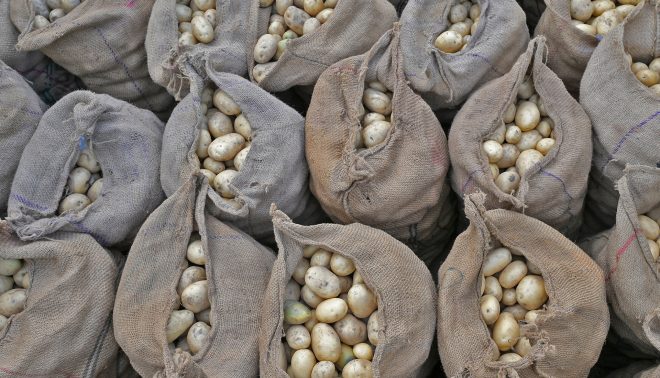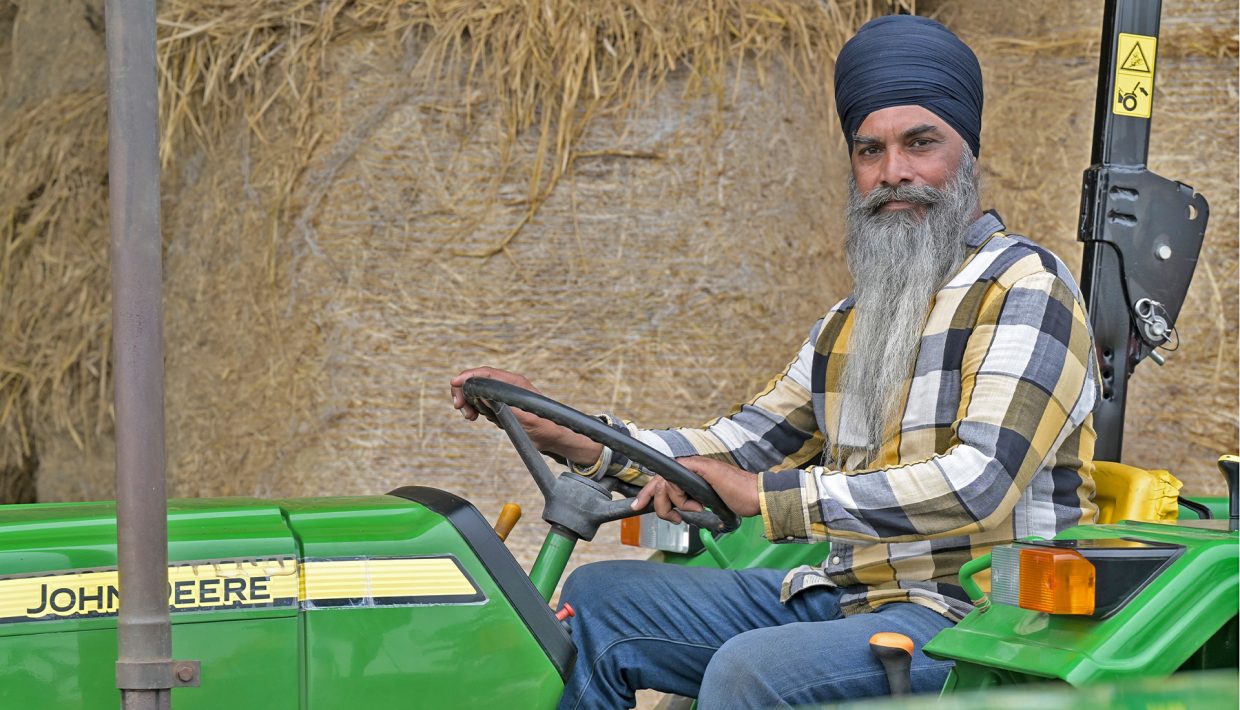As feared, the “Evil rain” fell before sunrise. “We had to cover mounds of freshly harvested seed potatoes until deep into the night, as they cannot have any contact with rain,” explains Jang Bahadur Singh Sangha in the large, manicured garden in front of his home. It is located in Quadian Wali, south of the city of Jalandhar, which is home to millions of residents in the state of Punjab – the name translating to “land of five rivers”.
It is a region that has always enjoyed a reputation as an agricultural El Dorado in India and beyond, thanks to its favourable climatic conditions, plentiful water, and nutritious soils. Indeed, Punjab is considered the “breadbasket” of India. For many years, it has offered farmers the option to harvest both rice and wheat within one year. This is a practice that has continued for several decades. Thus, despite the sensitive and sometimes sub-zero overnight temperatures at the start of the year, the wheat stands luscious, green, and monotone, dominating the wide, fertile flats of Punjab. However, there is much more than wheat and rice; sugar cane, cauliflower, mustard, potatoes, and other crops are cultivated.
“We managed everything in time, so we don’t have to deal with any damage,” says Bahadur Singh Sangha, visibly relieved. As modest as –he appears, he is, in fact, famous in the potato propagation world in Punjab, India, and across the globe. Because, with around 2,000ha of seed potatoes, his company, the Sangha Group, is one of the largest in the global potato cosmos. His team is, accordingly, immense. Around 3,000 seasonal workers are deployed in the fields, extending to a radius of 100 km, during the harvest. Moreover, there are 250 permanent employees on the payroll of the company, founded by his father, Hardev Singh Sangha, in 1962, and expanded with legendary passion.

Mit Wissen erntet der Chef viel Respekt
The boss enjoys great respect thanks to his knowledge. He is one of the self-made men who left big shoes to fill after Indian independence in 1947. His son knows only too well how to fill them since graduating in agriculture from Cornell University in the USA.
He has earned respect not only through his modesty, but also his profound knowledge – both in the potato business and among his employees. Nowhere is this more visible than in one of his many fields during the harvest. More than 200 John Deere tractors are utilised at this time. They pull Shaktiman harvesters from the German manufacturer, Grimme, among others, that lift the seed potatoes from the sandy, clay soil.

Under a covered sky, many hands help to sort the sensitive tubers according to size and then put them into a sack. Many harvest workers come from the generally poorer regions of India to find jobs here in the north-west. This situation is also the reason that many Punjabis migrate abroad to try their luck there. Canada seems attractive – migration agency advertisements can be seen everywhere: “You want to go to Canada? We assist you!”
Sangha goes straight to his employees, picks up the potatoes and inspects them with eagle eyes, to see if the skin has remained undamaged. He asks how the start of the harvest, which lasts until the beginning of April, has been going. Answers are quickly given, difficulties are expressed, the brief conversations are to the point. After half an hour, the boss has been able to get an idea of the harvest progress in the area and gets back into his black Jeep.
This year, we are using bacteria for the first time to try and release phosphate, zinc, potassium, and magnesium in the soil.
Jang Bahadur Singh Sangha
He drives to the new, huge cooling warehouse, where the seed potatoes, with a diameter of around four centimetres are stored at around 36 degrees Fahrenheit and optimal humidity. And of course, most of the power for the refrigeration comes from a photovoltaic plant that generates 300 kW of power on the roof. The Sangha Group stores around 60,000 tons of seed potatoes in 11 warehouses; with a combined power of 1.5 megawatts installed on their balconies.
Sangha is right up to date and fully informed about sustainability and climate change issues. But without microbiological know-how and clone technology, the company would not be where it is today. And it is favoured by the natural climatic situation in Punjab, where the temperature in December is around four degrees lower, on average, than in other regions in northern India. Perfect for seed potatoes.

However, Sangha, a board member of the World Potato Congress is concerned about the dramatically falling ground water level in Punjab – around three metres over the past three years. He is also unhappy with the falling humus content. On the other hand, he is very pleased with the mycorrhiza bacteria that help to promote the release of nutrients such as phosphorus, zinc, and potassium. The fact that Sangha is following innovative paths is also manifested in the development of an innovative potato sieve for a sorting machine that draws on the hexagonal structures of honeycombs.

Sangha is one of around 13,000 customers serviced by John Deere in the state of Punjab. Several dealers, such as the Singh Agro Company in Kapurthala, supply farmers with technology. It is mainly the cereal farmers who thresh wheat in April that sow in mid-November. Rice is planted at the start of June, before the monsoon season, and harvested in October.
Low wages, a lack of perspectives, and farmer protests
For Harpreet Singh, farmer and contractor in Jodhan, the economic labour pressure is on almost everywhere in Punjab. The rice has to be threshed, and the silicate-rich straw made into bales; then the seed bed has to be prepared for the subsequent wheat. The farmers who do not collect the rice straw burn it in the field. Thus, Punjab is often under thick smoke clouds for days in late autumn, which is far from sustainable in terms of energy, and health.
However, there are plans to ferment rice straw into biogas on a large scale in the future. The first straw fermentation plant, operated by Verbio India, went into production in Lehragaga recently and it has been generating biofuel (CNG) since then.

“During peak harvest times, we regularly work into the night with our balers,” explains 45-year-old Harpreet at his farm, where, in his father’s time, they milked 50 cows. But those days are over. Land and lease prices are increasing ceaselessly, while wages stagnate at a very low rate. For many young Sikhs, this is a reason to emigrate abroad. Producer prices are also extremely modest, which is why Harpreet also takes part in protests under the slogan “No Farmer, No Food”.
At his farm, fresh water from a well regularly shoots out of a pipe, drilled 80 metres deep into the earth to tap into the groundwater. A branched system of ducts, found everywhere in Punjab, supply the surrounding wheat fields. The ducts are either fed by river water, provided there is enough, or from groundwater.
The well water is about 68 degrees Fahrenheit. It tastes soft and wonderful. However, the well constructions everywhere have negative consequences. While falling groundwater levels mean that many farmers must drill deeper, at greater expense, many geologists and agricultural experts are now warning about this negative spiral – and even scientists at the famous agricultural university in Ludhiana.
An ambitious educational institute for all areas of agriculture was created here after the Indian state was founded. It spreads its influence far beyond the borders of the northern Indian state and enjoyed support from the entire Indian political scene. Not least because it was clear to everyone that high-performance agriculture was an essential backbone for a stable Indian society. The hopes were set down in the “Green Revolution”, the cultivation methods and techniques changed, and yields rose. However, today, everybody understands that solely focusing on high yields is a concept of yesteryear.

New impulses from science
Director at the Punjab Agricultural University, Dr S S Gosal says it is time for a rethink – and he speaks with surprising candour. “The humus content has reduced in recent years and the dramatically falling groundwater levels caused by intensive grain cultivation are forcing our hand,” says Gosal. “We always focused on plants in the past, but now we are concentrating more and more on the soil and interactions in the agricultural system in general.”

These are not small problems, particularly because the population is continuing to grow rapidly. The cities sprawl further, and streets and buildings of all kinds inexorably encircle good land. Urban structures are also reaching the fields of Armarjit Singh Laddi in the village of Rangian, west of the state capital of Chandigarh, that was built after the separation of the Indian subcontinent into India and Pakistan – during which Punjab was also divided – according to the plans of French architect Le Corbusier.

Now we are concentrating more and more on the soil and the interactions in the agricultural system in general.
Dr. Satbir Singh Gosal
While 15 of his seasonal employees from the state of Bihar cut the tall sugar cane and load it on to trailers in the picturesque late afternoon light, in the distance, cranes can be seen turning as they build new high-rise buildings. The sugar cane straw is made into small bales on the already harvested field areas. In addition to his main crop of sugar cane, Laddi also grows wheat and rice; as well as potatoes and eucalyptus on small areas and keeps ten cows. Laddi talks openly about operational processes.
In doing so, the wiry man embodies the agricultural power in Punjab with his attentive nature. These are self-confident and proud farmers who know exactly what the favourable natural space offers them. And they decisively convey a readiness to face the agricultural challenges of the future.




